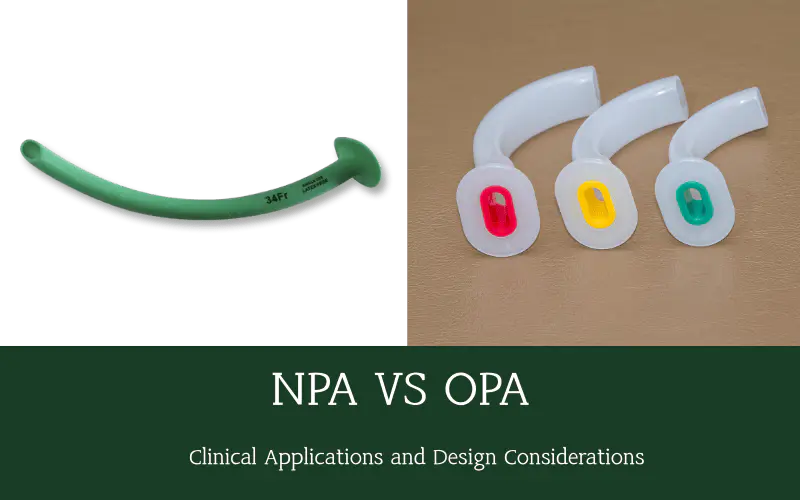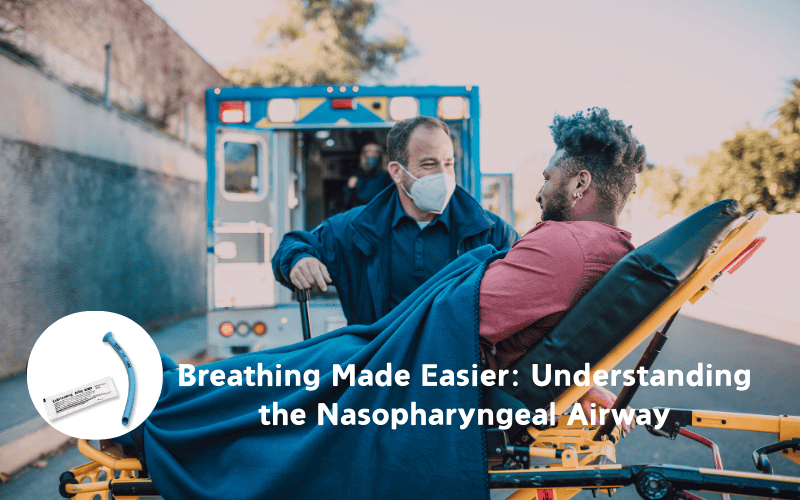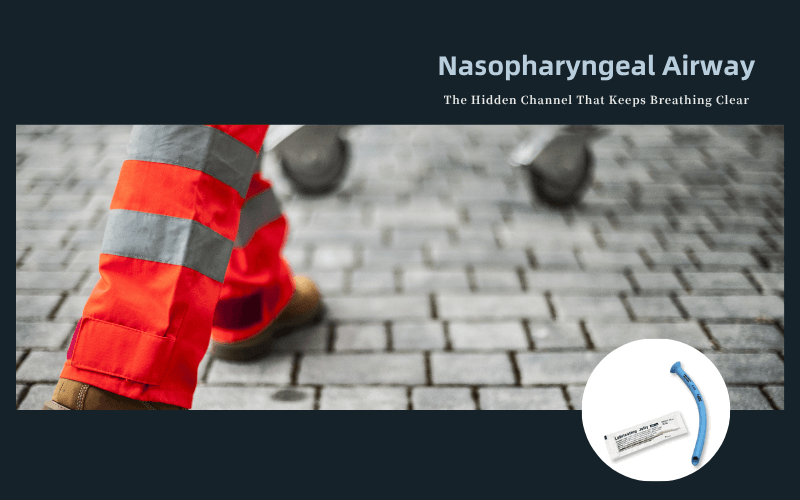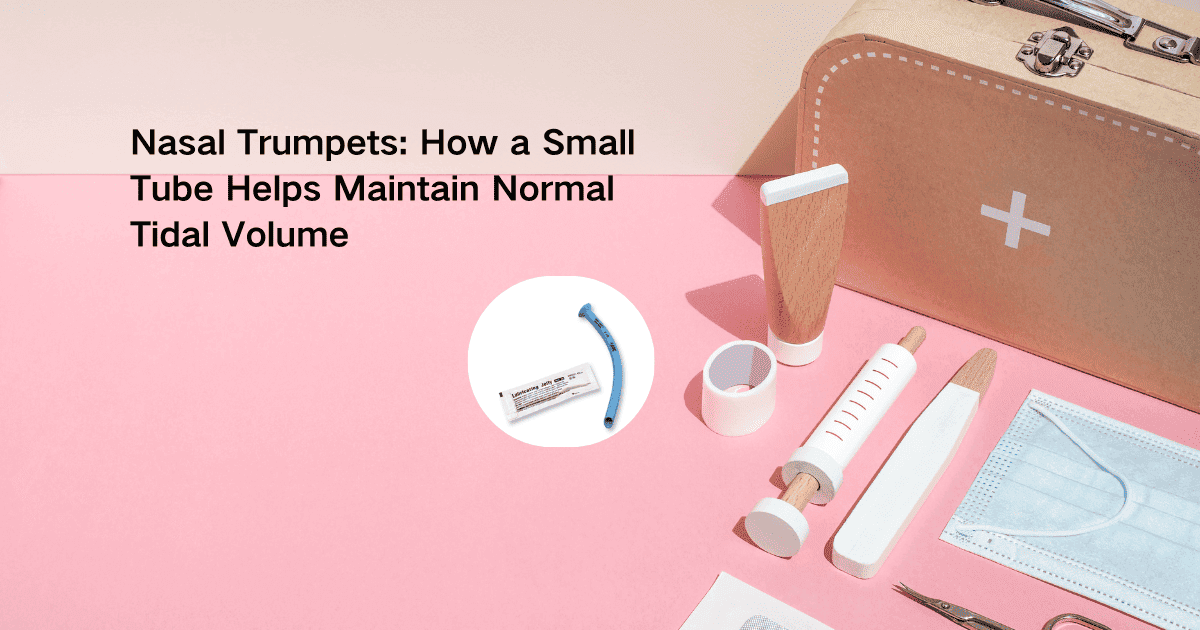In airway management, selecting the appropriate airway adjunct is critical for ensuring patient safety, improving ventilation efficiency, and supporting clinical workflows. The nasopharyngeal airway (NPA) is a widely used device across emergency medicine, anesthesia, and critical care settings. For hospitals, EMS providers, and medical distributors, understanding when and why NPAs are used is essential for proper product selection, inventory planning, and clinical standardization. Overview of the Nasopharyngeal Airway A nasopharyngeal airway is a flexible tube inserted through the nasal passage to maintain upper airway patency. It creates a clear airflow channel by bypassing the tongue and relaxed soft tissues, reducing the risk of airway obstruction in patients with compromised airway tone. NPAs are commonly manufactured from medical-grade PVC or silicone, offering flexibility, biocompatibility, and cost efficiency. Standard design features include a beveled distal tip for atraumatic insertion and a proximal flange to prevent over-insertion. Primary Clinical Indications 1.Partial Upper Airway Obstruction NPAs are primarily indicated for patients experiencing partial airway obstruction, often due to reduced muscle tone caused by sedation, neurological impairment, or trauma. Unlike more invasive airway devices, NPAs provide effective airway support while allowing spontaneous breathing. 2.Patients With an Intact Gag Reflex Compared with oropharyngeal airways (OPAs), NPAs are better tolerated in conscious or semi-conscious patients. This expands their clinical applicability and reduces the risk of gagging or vomiting. 3.Emergency and Prehospital Applications In EMS and emergency department settings, NPAs are widely used as a first-line airway adjunct in trauma, overdose, or acute respiratory compromise. Their rapid deployment and minimal training requirements make them essential disposable airway consumables. 4.Procedural Sedation and Anesthesia Support NPAs are commonly used during procedural sedation in dental clinics, endoscopy units, and ambulatory surgery centers, where airway tone may be reduced but invasive airway management is not indicated. 5.Post-Anesthesia and Recovery Care In postoperative recovery units, NPAs help prevent airway collapse, particularly in patients with obstructive sleep apnea (OSA) or obesity, reducing the need for continuous manual airway maneuvers. Special Use Scenarios NPAs are particularly valuable in patients with trismus, jaw clenching, oral trauma, or neurological impairment, where oral airway placement is difficult or contraindicated. With proper sizing, they are suitable for pediatric, adult, and geriatric patients. Contraindications and Risk Management NPAs should not be used in patients with: Suspected basilar skull fracture Severe nasal or midface trauma Significant nasal obstruction or active epistaxis Clear labeling, IFU documentation, and clinical training are essential to mitigate misuse. Importance of Sizing and Product Selection Correct sizing is critical for ensuring airway effectiveness and minimizing complications such as epistaxis or inadequate ventilation. Clinically, NPA length is typically measured from the nostril to the tragus of the ear or the angle of the mandible. From a procurement and distribution perspective, offering a complete and clearly labeled size range is essential for supporting multi-department clinical use. Nasopharyngeal Airway Size Chart (Reference) French Size (CH / Fr) Internal Diameter (mm) Typical Patient Group CH 12 4.0 mm Infant / Small Child CH 14 4.7 mm Child CH 16 5.3 mm Small Adult / Adolescent CH 18 6.0 mm Adult (Average) CH 20 6.7 mm Large Adult CH 22 7.3 mm Large Adult / Bariatric Note: Final size selection should always be based on clinical assessment and institutional protocols. For detailed specifications, available sizes, materials, and packaging options, please refer to our Nasopharyngeal Airway product page. For suppliers and OEM partners, consistent sizing standards, smooth surface finish, adequate lubrication compatibility, and packaging options (sterile or non-sterile) are key product differentiation factors. Benefits for Healthcare Facilities and Distributors From a B2B perspective, nasopharyngeal airways offer: Broad clinical applicability across departments High patient tolerance Low unit cost and high inventory turnover Minimal training requirements Compatibility with existing airway management systems These attributes make NPAs a core SKU in emergency and anesthesia product portfolios. Conclusion The nasopharyngeal airway is a reliable, versatile airway adjunct widely used across emergency care, anesthesia, and recovery settings. Understanding clinical indications, contraindications, and correct sizing enables healthcare providers, distributors, and OEM partners to make informed decisions that support patient safety and operational efficiency. When integrated into standardized airway management protocols, NPAs deliver consistent clinical and commercial value across global healthcare markets.
View More +-
15 Dec 2025
Maintaining a patent airway is a fundamental priority in emergency care, anesthesia, and critical care. Among basic airway adjuncts, nasopharyngeal airways (NPA) and oropharyngeal airways (OPA) are widely used to help prevent upper airway obstruction caused by soft tissue collapse. Although these devices are simple in concept, their effective use depends on understanding not only when to use them, but also why they are designed the way they are. This article explores NPA and OPA from a practical perspective, focusing on application scenarios, material selection, and design philosophy, and concludes with guidance on patient suitability. 1.Understanding NPA and OPA Nasopharyngeal airways (NPA) are inserted through the nasal passage and extend into the nasopharynx to maintain airflow. Oropharyngeal airways (OPA), by contrast, are inserted through the mouth and rest over the tongue to prevent it from occluding the airway. Both devices are intended to support spontaneous breathing and are commonly used as temporary airway adjuncts in emergency and clinical settings. 2. NPA and OPA Clinical Application Scenarios The choice between NPA and OPA is driven primarily by patient condition and tolerance. NPA is often used in patients who are semi-conscious or who retain protective airway reflexes. Because it bypasses the oral cavity, it is generally better tolerated and less likely to provoke gagging in these patients. NPA is also useful when oral access is limited due to clenched teeth, oral trauma, or restricted mouth opening. OPA is typically indicated for unconscious patients who lack a gag reflex. In these cases, OPA provides reliable tongue displacement and helps maintain airway patency with minimal resistance. In emergency and prehospital environments, the clinical setting itself also influences device selection. Time pressure, patient cooperation, and limited resources often favor the device that can be placed quickly and safely while minimizing complications. 3.Materials Used in NPA and OPA Material selection for nasopharyngeal airways (NPA) and oropharyngeal airways (OPA) is based on anatomical pathways and clinical use rather than a fixed material rule. PVC is widely used for NPA due to its cost-effectiveness and suitability for single-use applications. Pre-lubricated PVC NPA are commonly adopted to support smoother nasal insertion in emergency and routine care settings. Medical-grade silicone NPA are also available when enhanced softness and patient tolerance are required, particularly for sensitive patients. PVC OPAairways OPA are predominantly manufactured from PVC for disposable clinical use, as they are typically applied in unconscious patients for short-term airway support where firmness and stable tongue displacement are essential. Silicone OPA exist mainly in limited or reusable formats and are not commonly used in routine disposable airway management. 4.Design Philosophy Behind NPA and OPA The design of airway adjuncts reflects anatomical and functional considerations. NPA is designed with a gentle curvature to follow the natural anatomy of the nasal passage. Features such as a flared proximal end or adjustable flange help prevent over-insertion and enhance positioning safety. Length and diameter options allow clinicians to select an appropriate size for different patient populations. OPA design focuses on effective tongue displacement while minimizing pressure on oral structures. The curved profile mirrors oral anatomy, and reinforced bite sections help maintain patency even in patients with jaw movement. These design elements are not arbitrary; they are intended to balance airway effectiveness with patient safety and tolerance. 5.Advantages and Limitations of NPA and OPA Advantages of NPA Better tolerance in semi-conscious patients Can be used when oral access is limited Useful in prehospital and emergency settings Limitations of NPA Risk of nasal trauma or bleeding Contraindicated in suspected basilar skull fracture Advantages of OPA Simple and effective in unconscious patients Reliable tongue control and airway opening Limitations of OPA Poor tolerance in conscious or semi-conscious patients Risk of gagging, vomiting, or aspiration if misused Understanding these strengths and limitations helps reduce complications and improve clinical outcomes. 6.Patient Groups and Device Selection No single airway adjunct is appropriate for all patients. NPA is often better suited for patients who are partially conscious, elderly, or unable to tolerate oral devices. OPA remains a valuable option for deeply unconscious patients who require immediate and effective airway support. Ultimately, airway adjunct selection should be based on patient assessment, risk evaluation, and clinical context rather than habit or convenience. 7.BEVER Medical Nasopharyngeal Airway Solutions To support diverse clinical requirements, BEVER Medical offers a range of nasopharyngeal airway products designed with different materials and functional features. These include adjustable NPA designs that allow flexible positioning, PVC NPA with pre-lubricated surfaces for ease of insertion, and medical-grade silicone NPA options developed to enhance patient comfort and biocompatibility. By offering multiple configurations, BEVER Medical aims to support clinicians in selecting airway solutions that align with specific patient needs and care environments. Conclusion Nasopharyngeal and oropharyngeal airways are essential tools in basic airway management, but their effective use depends on informed clinical judgment. Understanding application scenarios, material properties, and design intent allows healthcare professionals to select the most appropriate device for each patient. In airway management, the right choice is rarely about the device alone it is about matching design and function to the clinical situation.
View More + -
01 Dec 2025
A nasopharyngeal airway (NPA), often called a "nasal trumpet," might look simple, but it plays a vital role in ensuring safe and effective breathing. This soft, hollow tube is inserted gently through the nostril into the upper throat, creating a direct passage for air when a patient's natural airway is at risk. Unlike oral airways, NPAs are well-tolerated by patients who are semi-conscious or have an intact gag reflex, making them invaluable in emergency and clinical care. How an NPA Works Think of the NPA as a tiny, invisible highway for air. When a patient's tongue or soft tissues collapse backward, airflow can be blocked. By holding these tissues aside, the NPA ensures oxygen reaches the lungs effortlessly. Key Functions of an NPA Facilitate oxygen delivery and ventilation Allow gentle suctioning of mucus and secretions Serve as temporary support when oral access is limited, such as after facial trauma or during swelling In practice, this simple device can make a significant difference, bridging the gap between basic airway management and more advanced interventions (Starship Hospital Guidelines, StatPearls). A Quick Look at Its Evolution Introduced in the late 1950s, the NPA has evolved from a simple rubber tube to a flexible, anatomically designed PVC device. Modern designs include soft material, flared ends to prevent over-insertion, and sizes suitable for both children and adults. These improvements enhance patient comfort while reducing complications, making NPAs a standard in emergency medicine, anesthesia, and intensive care. When to Use an NPA NPAs are especially useful in situations where airway compromise is likely, and oral devices are unsuitable: Typical Scenarios Semi-conscious or drowsy patients Those who cannot tolerate oral airways Patients with limited mouth opening due to swelling, trauma, or dental procedures During oxygen therapy or bag-valve-mask ventilation For clearing secretions in the nasopharyngeal region By providing a safe, minimally invasive pathway for airflow, NPAs help ensure patients can breathe comfortably and reliably. Potential Risks and How to Avoid Them While NPAs are generally safe, they must be used properly. Common Risks Nasal bleeding or mucosal injury Improper placement causing obstruction Rare but serious complications, such as intracranial insertion in skull base fractures These risks can be minimized by selecting the correct size, using soft PVC material, lubricating the tube, inserting gently along the nasal floor, and monitoring the patient continuously. Choosing the Right NPA The ideal NPA balances safety, comfort, and effectiveness. Selection Guidelines Proper length: reaches from nostril to roughly the earlobe Soft, flexible PVC with a beveled tip Flanged ends to prevent over-insertion Regular monitoring for displacement or irritation Following these simple rules ensures the device works as intended while keeping the patient comfortable. Why BEVER Medical PVC NPA Stands Out BEVER Medical offers high-quality PVC NPAs designed with both patient comfort and clinical practicality in mind. Their tubes are soft and flexible, with safety flanges and multiple sizes for all ages. Whether used for emergency airway management, oxygen delivery, or temporary support, BEVER NPAs make clinical procedures smoother and safer, reflecting years of experience in medical device design. Conclusion The nasopharyngeal airway may be a small device, but its impact is enormous. By providing a safe passage for airflow, it protects patients when their natural airway is compromised. With careful selection, proper insertion, and reliable monitoring, NPAs are a trusted tool in hospitals, clinics, and emergency care settings. BEVER Medical's PVC NPAs bring comfort, safety, and efficiency together, ensuring every breath counts.
View More + -
19 Nov 2025
The Amy Nasopharyngeal Airway—also known as the Amy Nasopharyngeal Airway Tube—is widely used in emergency and tactical environments. It is standard equipment in military field medical kits, tactical emergency care training, and wilderness rescue teams. Its ease of insertion and dependable design make it ideal for maintaining airway patency when oral access is limited. Material Types of Amy Nasopharyngeal Airways PVC Nasopharyngeal Airway Medical-grade PVC offers a practical combination of flexibility and strength. It is commonly used in large-volume procurement programs, EMS kits, and military distribution systems. Silicone Nasopharyngeal Airway Silicone NPAs provide maximum softness and biocompatibility. They minimize irritation and are frequently selected by hospitals, anesthesia departments, and advanced rescue units. Functional Design Variations Fixed-Flange Nasopharyngeal Airway (Classic Amy Design) The traditional Amy-style NPA includes a fixed flange that prevents over-insertion. It is valued for its simplicity, reliability, and consistent performance in field conditions. Silicone Adjustable Nasopharyngeal Airway The PVC Adjustable Nasopharyngeal Airway includes a movable flange that allows depth adjustment. This design increases adaptability when treating different patient profiles and reduces the number of fixed sizes needed in compact kits. Professional Sizing Guide for Nasopharyngeal Airway Tubes Common Sizing Recommendations Patient Type Size Range (Fr) Small adults / older adolescents 20–24 Fr Average adults 26–30 Fr Larger adults 32–36 Fr Length Estimation Method A useful field technique is measuring from the nostril to the earlobe or the angle of the mandible to approximate ideal NPA length. Key Considerations During Sizing Select a size that ensures comfort and airflow. Use sufficient lubrication. If resistance occurs, switch nostrils rather than forcing placement. Position the bevel toward the nasal septum. Application Scenarios and Precautions Typical Application Scenarios Tactical emergency training Remote or wilderness rescue Prehospital airway support Situations where oral airway access is limited Precautions and Suitable Use Avoid use in the presence of significant nasal trauma. Evaluate carefully in suspected mid-face injuries. Monitor for discomfort or bleeding during insertion. Use only by personnel with appropriate training. Amy Nasopharyngeal Airway Solutions from BEVER Medical Silicone Adjustable Nasopharyngeal Airway Medical-grade silicone construction Soft and flexible for improved tolerance Adjustable flange for depth control Smooth beveled tip for easy insertion Available in a full range of French sizes Silicone Nasopharyngeal Airway Ultra-soft, medical-grade silicone Enhanced patient comfort EO-sterilized Optional pre-lubricated version Pre-Lubricated Nasal Airway (PVC or Silicone) Ready-to-use format Efficient for EMS, military, and rescue kits Multiple sizes for various patient needs BEVER Medical supports distributors, military procurement teams, emergency-response suppliers, and global medical device brands with consistent manufacturing quality and reliable product availability.
View More + -
24 Oct 2025
In clinical anesthesia and emergency care, maintaining a patent airway is one of the most fundamental and lifesaving tasks. When oral access is limited, intubation is difficult, or the patient presents with trismus (jaw clenching), the nasopharyngeal airway (Nasal Trumpet ) can serve as an effective temporary measure. Simple in appearance yet powerful in function, it helps maintain airflow and prevents airway obstruction in patients who are semi-conscious but retain protective reflexes. 1. What Is a Nasopharyngeal Airway? A nasopharyngeal airway is a soft, flexible tube inserted through the nostril into the nasopharynx, creating a passage for air to reach the lower airway. Its main function is to prevent obstruction caused by the tongue or soft tissue collapse, which can occur in patients with reduced consciousness. NPAs are appropriate for patients who require airway support but cannot tolerate an oropharyngeal airway, such as those with partial consciousness or limited mouth opening. 2. Materials and Design Modern NPAs are typically made from medical-grade PVC or TPE, providing a balance of flexibility and firmness suitable for safe insertion. Many feature rounded, atraumatic tips and smooth internal walls to reduce friction and mucosal trauma. Some designs come pre-lubricated with water-soluble gel, simplifying insertion in emergency situations. Size selection is crucial: the correct length is generally measured from the tip of the nose to the earlobe or angle of the jaw, and the diameter should allow comfortable placement without causing nasal trauma. 3. Clinical Applications Nasopharyngeal airways are widely used in various settings: Emergency medicine and prehospital care: to maintain airway patency when intubation is delayed or difficult. Anesthesia and surgery: to prevent airway obstruction during sedation or minor procedures. Critical care transport: providing a temporary airway during movement. Patients with trismus or oral injuries: when oral airway devices cannot be safely inserted. Insertion should follow the nasal floor parallel to the palate, with adequate lubrication, and care should be taken in patients with suspected basal skull fractures or severe facial trauma. 4. Advantages NPAs offer several practical benefits in clinical care: Maintains spontaneous breathing and airway patency. Reduces risk of airway obstruction from tongue or soft tissue collapse. Compatible with oxygen delivery and suctioning in emergency settings. Relatively easy and rapid to use, even outside the hospital. Minimal trauma when properly inserted, making them suitable for repeated or short-term use. 5. Safety Considerations While generally safe, NPAs must be used with caution in: Patients with suspected basal skull fractures or severe nasal/facial trauma. Cases where improper sizing could cause gagging, laryngospasm, or inadequate airway support. Situations requiring strict infection control — single-use or sterilized devices are recommended. Proper monitoring during use is essential to detect any complications such as nasal bleeding, displacement, or obstruction. 6. Conclusion The nasopharyngeal airway remains a simple yet indispensable tool for maintaining a patent airway in semi-conscious or difficult-to-manage patients. Its design and ease of use make it a cornerstone of emergency airway management, prehospital care, and procedural sedation. Modern products combine ergonomic design, soft atraumatic tips, color-coded sizing, and pre-lubrication options to improve both patient safety and procedural efficiency.
View More + -
08 Oct 2025
A nasopharyngeal airway is also known as a nasal trumpet or nasopharyngeal trumpet. This tool is powerful in emergency medicine, though it looks small and soft. NPAs play a great role in helping patients breathe smoothly and maintain normal tidal volume, even in challenging situations. In this article, we'll discuss how the nasal airway helps maintain healthy breathing patterns. What Is a Nasal Trumpet? In medical terms, we call it a nasopharyngeal airway. The flared end looks like a tiny trumpet, where it gets its nickname. A nasal trumpet is basically a soft, flexible tube—usually made of rubber or silicone, which you can find these devices made of materials you mentioned at Bever Medical. Usage of them is gently sliding through the nose down to the back of the throat. Before using, ensure your patients can open their mouths. Besides, you should get to know the following suitable usage situations: Is semi-conscious or unconscious Can't open their mouth because of trauma Has dental work or injuries that make oral devices tricky In short, it's a simple tool that keeps the airway open and makes sure air can flow freely into the lungs. What Is Tidal Volume? Before we go further, it's important to know the definition of tidal volume. Tidal volume (TV) refers to the amount of air inhaled or exhaled in a single breath during normal, relaxed breathing. In healthy adults, normal tidal volume is typically about 400–600 mL per breath, or roughly 7 mL per kilogram of body weight. It's crucial to keep proper tidal volume because it ensures enough oxygen reaches the lungs and, consequently, the bloodstream. When tidal volume drops, oxygen delivery to vital organs can be compromised, which is dangerous in any emergency situation. How Nasopharyngeal Airways Help Maintain Normal Tidal Volume Sometimes, the body's natural airway can become partially blocked. This is especially common when someone is unconscious, and the tongue falls back toward the throat. Even if the chest and diaphragm are working normally, airflow can be restricted, which reduces tidal volume. This is where a nasopharyngeal airway or nasal trumpet becomes essential. By gently bypassing the tongue and soft tissues, the device allows air to flow freely to the lungs. With an open airway, the patient can breathe with normal tidal volume, ensuring adequate oxygenation. In other words: A nasal trumpet does not “push” more air into the lungs—it simply clears the path, allowing the patient's natural breathing to achieve a normal tidal volume. Why the Army Relies on NPAs Military medics are trained to deal with emergencies where airway obstruction is common. In battlefield conditions, soldiers may be: Unconscious Suffering facial trauma Wearing helmets or gear that complicates oral airway insertion In such cases, a nasopharyngeal airway army version is included in first-aid kits because it: Can be inserted quickly Works even when the mouth is inaccessible Minimizes gag reflex Helps maintain normal tidal volume immediately Consider a scenario: a soldier is knocked unconscious during training, and his tongue partially blocks his airway. Without intervention, his tidal volume drops, oxygenation decreases, and he risks severe complications. In seconds, a medic inserts a nasal trumpet, restoring airflow and normal tidal volume, stabilizing him until further care arrives. Everyday and Clinical Uses While nasal trumpets are well-known in military settings, they are also widely used in civilian medical practice: Emergency rooms: For unconscious patients who are breathing but at risk of airway obstruction Ambulances: To ensure safe transport of trauma patients Sleep medicine: Sometimes used to relieve mild airway obstruction in patients with sleep apnea Dental procedures: When sedation is involved and mouth opening is limited In each of these situations, the key benefit remains: keeping the airway open and ensuring adequate tidal volume. Safe Use Guidelines To use a nasal trumpet safely: Choose the correct size: Too small may be ineffective; too large can cause trauma. Lubricate well: Prevents nasal tissue damage and eases insertion. Insert gently: Always follow the curve of the nasal passage. Avoid contraindicated cases: Do not use if there's a suspected basal skull fracture. Monitor breathing: Check that tidal volume and oxygen saturation remain adequate. Remember, improper insertion can cause nasal bleeding or, in rare cases, worsen airway obstruction. Training and practice are essential. Signs a Nasal Trumpet Is Working Once inserted correctly, you should observe: Smooth, unobstructed breathing Normal rise and fall of the chest Adequate tidal volume, meaning the person takes full breaths without visible struggle Reduced snoring or gurgling sounds caused by airway obstruction These signs indicate that the device is helping maintain normal tidal volume effectively. Conclusion From battlefield medics to emergency rooms, nasopharyngeal airways ensure patients to breathe effectively, keeping their tidal volume stays within the normal range. After knowing how these devices work, both medical professionals and curious patients can appreciate the importance of airway management, even in the smallest forms. If you're looking for high-quality nasal trumpets for professional or emergency use, welcome to explore our full range of airway products, medical-gradd material guarantee, reliability, and ease of use. Equip your medical kit today and be prepared for any situation.
View More +








